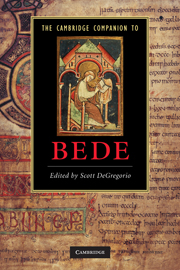Book contents
15 - Bede in later Anglo-Saxon England
from Part III - Reception and Influence
Published online by Cambridge University Press: 28 January 2011
Summary
“'It is not hard. Take your pen and mend it, and then write fast.'” - Bede / The epigraph comes from a story related by Bede's student, Cuthbert, in a letter he wrote to a fellow student describing their teacher's death. In the story, young Wilberht asks Bede, who is on his deathbed, if it would be too hard to finish dictating the book he is writing. Bede replies as above. According to the story, he finishes his task before his peaceful death. Cuthbert's letter, which includes the short English poem known as 'Bede's Death Song', was widely circulated in England and the continent in the early Middle Ages; it survives in over forty manuscripts from the ninth to the twelfth centuries. Whether the story recounts the truth about Bede's dying words and actions is imponderable, but the letter, its circulation and the story it contains reveal how Bede's students revered him. His students, including Cuthbert and Egbert (archbishop of York, 735-66), played a crucial role in popularizing and preserving Bede's writings. They spread his books, reputation and teaching style into the later Anglo-Saxon period. Egbert's student, Alcuin (c. 735-804), abbot of Tours, took many of Bede's writings to the court of Charlemagne, where they were incorporated into the Carolingian Reform, a channel via which they later returned to England.
- Type
- Chapter
- Information
- The Cambridge Companion to Bede , pp. 216 - 228Publisher: Cambridge University PressPrint publication year: 2010
- 3
- Cited by

